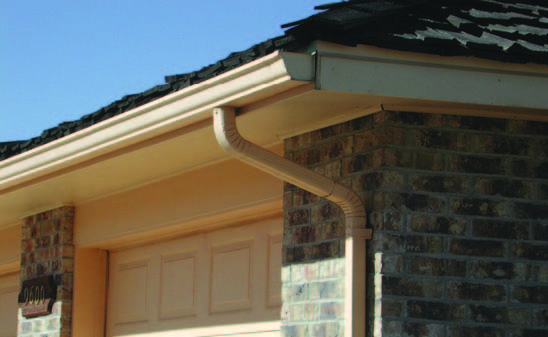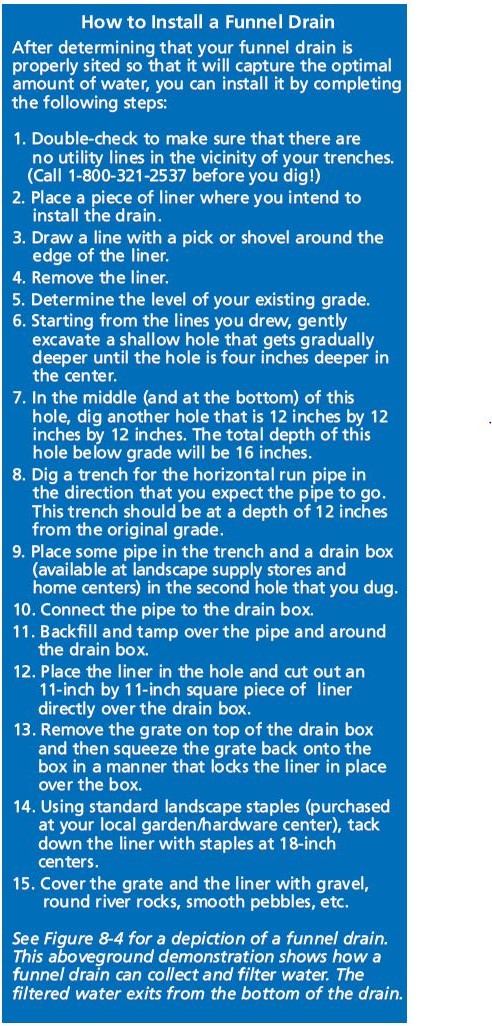The PermaDesign Weblog, with Nate Downey and Melissa McDonald!
Roof-Reliant Landscaping™ Step 16C: Water Conveyance - Vertical Drop

Figure 8-3: Photo of a downspout. Downspouts funnel water
from gutters along a vertical drop.
In most water harvesting systems, there is at least one place in the conveyance system with a sharp vertical drop. From pitched roofs, this is typically a downspout. From flat roofs, this is usually the arc of projected precipitation off of the edge of a canale. Harvesting water that free-falls from a canale imposes a need to efficiently direct the runoff. This manual offers three methods to deal with the vertical-drop issues associated with canales: funnel drains, downspout-canale connections and in-wall drainpipes.
Most roofs have more than one vertical-drop point. If, however, you can limit the number of these points in your design, you often can save money in the installation process. This of course assumes that your roof can handle the limited number of vertical-drop points during large storm events.
Downspouts
Downspouts are the pipes that direct water vertically from gutters toward cisterns. It is recommended that your downspouts be made of the same material as your gutters and that you affix them to your structure, as in Figure 8-3. Connections between gutters and downspouts should be monitored periodically for leaks and blockages.
Downspouts are highly efficient at conveying water along a vertical drop. They are also very precise at directing runoff, so the water they convey is less expensive to control than the water associated with canale drains (see next section). Aluminum, galvanized steel and vinyl downspouts normally come in two-inch by three-inch or threeinch by four-inch rectilinear sizes, but downspouts can also be cylindrical pipes made of polyvinyl chloride (PVC), steel and corrugated metal.
For the do-it-yourselfer, vinyl is a good downspout choice since it comes in manageable lengths with an assortment of parts that can be fit together quickly and easily. Aluminum gutters and downspouts are economical and relatively easy to install. Wood gutters are used primarily in special applications, such as historic preservation, due to their extra expense and fire-hazard potential.
Funnel Drains
A funnel drain catches water that falls from a canale. It does this by directing roof water through a rubber or vinyl liner (such as EPDM pond liner, which is a highly flexible synthetic rubber material that is commonly used to line decorative ponds) into a below-grade box drain. A top dressing of gravel or river rock covers the liner to protect it from degrading in the intense New Mexico sun and hides the drain from view. Most importantly, the gravel prevents mulch, soil and other particulate from being conveyed toward your cistern. This gravel becomes the first step in the filtration of the captured water.

Figure 8-4. An above ground demonstration of how a funnel drain works. Materials, shapes and proportions of funnel
drains can vary.
When determining the location for a funnel drain, take into account the fact that roof water can arc far away from a structure (especially during intense storm events). Other times—at the beginning and the end of storm events, during light storms and when snow melts off of a roof—significant quantities of roof water drip straight down from the canale along what is called the drip line. In storm events that are associated with gusty winds, the collected roof water may be blown against your building, away from your building, or sideways, out of range of your funnel drain.
To combat the variable nature of the trajectory of the water, funnel drains are located in the ground at least four inches below grade and about 12 inches out from the drip line of the canale. The edge of the liner should start against the house and protrude at least three feet from the drip line, the point directly below a canale where it literally drips tiny amounts of water. Different liner materials come in different widths; standard five-foot-wide liners are typically sufficient for one-story structures, while a minimum of a six-foot-wide funnel should be used for two-story structures. Make sure that your funnel drain is pitched in such a way that water does not settle against your building, particularly in the case of adobe structures.
01/23/2016 | (2) Comments











Comments
So true. This is a wonderful and valuable share. I agree with you that cleaning the gutters is essential. Right gutter repair involves replacing some parts or reinforcing it with more hangers. I am a professional gutter cleaner.
I must say, this blog post on dealing with the vertical-drop issues associated with canales in water harvesting systems has been highly informative. The explanation of the different vertical-drop points, such as downspouts from pitched roofs and the arc of precipitation from canales on flat roofs, highlights the challenges in efficiently directing the runoff.
The three methods outlined in the manual, including funnel drains, downspout-canale connections, and in-wall drainpipes, offer practical solutions to address these vertical-drop issues. Each method provides a unique approach based on the specific requirements of the water harvesting system. This comprehensive coverage of different techniques allows readers to choose the most suitable option for their specific situation.
I particularly appreciate the mention of limiting the number of vertical-drop points in the design to save on installation costs. It’s a valuable insight that highlights the importance of considering the capacity of the roof to handle these points during heavy storm events. This consideration ensures both efficiency and cost-effectiveness in the long run.
Thank you for sharing this detailed and practical guide. It has expanded my understanding of water harvesting systems and the strategies to overcome vertical-drop challenges. The inclusion of multiple methods provides readers with a range of options to adapt to their unique requirements. Well done!